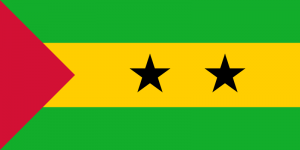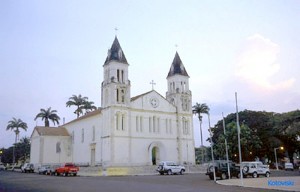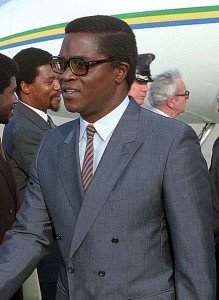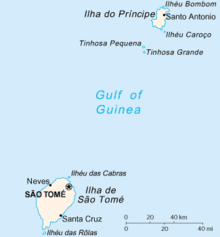São Tomé and Príncipe

Today in History: Independence Days of Kiribati, São Tomé and Príncipe July 12, 2010
On this day, July 12, 2010 is the Independence Day of Kiribati, commemorating its self-rule achieved in 1979. Located on bothsides of the equator southwest of Hawaii, Kiribati is an archipielago of more than 30 coral atolls. One of them, Kirimati of Christmas Island, is the largest of coral atoll in the world. It is a sanctuary for many species of birds. The nation Phoenix Island Marine Protected Area, the most sizeable in the Pacific Ocean, is over 400,000 square kilometers and includes a large area of deep ocean. Also this is the independence Day of São Tomé and Príncipe, observeing its attaiment of autonomy in 1975. Some of the globe´s rarest birds are found on these islands west of Gabon in western Africa. The Obo National Park covers 30% of the country. It is home to primary rainforest and over 100 species of orchids. May the Kind people of Kiribati and São Tomé and Príncipe have memorable Independence Day.
São Tomé and Príncipe (/ˌsaʊ təˈmeɪ ən ˈprɪnsɨpə/ sow-tə-may-ən prin-si-pə or/ˌsaʊ tɒˈmeɪ ən ˈprɪnsɨpeɪ/ sow-to-may-ən prin-si-pay; Portuguese pronunciation: [sɐ̃w̃ tuˈmɛ i ˈpɾĩsɨpɨ]) officially the Democratic Republic of São Tomé and Príncipe, is a Portuguese-speaking island nation in the Gulf of Guinea, off the western equatorial coast of Central Africa.
It consists of two archipelagos around the two main islands: São Tomé andPríncipe, located about 140 kilometres (87 mi) apart and about 250 and 225 kilometres (155 and 140 mi), respectively, off the northwestern coast of Gabon. Both islands are part of an extinct volcanic mountain range. São Tomé, the sizable southern island, is situated just north of the equator. It was named in honour of Saint Thomas by Portuguese explorers who arrived at the island on his feast day.
With an estimated population of 172,000(2012), São Tomé and Príncipe is the second-smallest African country (Seychelles is the smallest African country). It is also the smallest Portuguese-speaking country.
History of São Tomé and Príncipe
The islands of São Tomé and Príncipe were uninhabited before the arrival of the Portuguese sometime around 1470. The islands were discovered by João de Santarém and Pêro Escobar. Portuguese navigators explored the islands and decided that they would be good locations for bases to trade with the mainland.
The dates of discovery are sometimes given as December 21 (St Thomas’s Day), 1471 for São Tomé, and January 17 (St Anthony’s Day), 1472 for Príncipe, though other sources give different nearby years. Príncipe was initially named Santo Antão(“Saint Anthony”), changing its name in 1502 to Ilha do Príncipe (“Prince’s Island”), in reference to the Prince of Portugal to whom duties on the island’s sugar crop were paid.
The first successful settlement of São Tomé was established in 1493 by Álvaro Caminha, who received the land as a grant from the crown. Príncipe was settled in 1500 under a similar arrangement. Attracting settlers proved difficult, however, and most of the earliest inhabitants were “undesirables” sent from Portugal, mostly Jews. In time these settlers found the volcanic soil of the region suitable for agriculture, especially the growing of sugar.
The cultivation of sugar was a labor-intensive process and the Portuguese began to import large numbers of slaves from the mainland. By the mid-16th century the Portuguese settlers had turned the islands into Africa’s foremost exporter of sugar. São Tomé and Príncipe were taken over and administered by the Portuguese crown in 1522 and 1573, respectively.
However, superior sugar colonies in the Western Hemisphere began to hurt the islands. The large slave population also proved difficult to control, with Portugal unable to invest many resources in the effort. Sugar cultivation thus declined over the next 100 years, and by the mid-17th century, the economy of São Tomé had changed. It was now primarily a transit point for ships engaged in the slave trade between the West and continental Africa.
In the early 19th century, two new cash crops, coffee and cocoa, were introduced. The rich volcanic soils proved well suited to the new cash crop industry, and soon extensive plantations (known as “roças”), owned by Portuguese companies or absentee landlords, occupied almost all of the good farmland. By 1908, São Tomé had become the world’s largest producer of cocoa, which remains the country’s most important crop.
The roças system, which gave the plantation managers a high degree of authority, led to abuses against the African farm workers. Although Portugal officially abolished slavery in 1876, the practice of forced paid labor continued. Scientific American magazine documented in words and pictures the continued use of slaves in São Tomé in its March 13, 1897 issue. In the early 20th century, an internationally publicized controversy arose over charges that Angolan contract workers were being subjected to forced labor and unsatisfactory working conditions. Sporadic labor unrest and dissatisfaction continued well into the 20th century, culminating in an outbreak of riots in 1953 in which several hundred African laborers were killed in a clash with their Portuguese rulers. This “Batepá Massacre” remains a major event in the colonial history of the islands, and its anniversary is officially observed by the government.
Independence
 The cathedral – Sé – of São Tomé
The cathedral – Sé – of São Tomé
By the late 1950s, when other emerging nations across the African Continent were demanding independence, a small group of São Toméans had formed the Movement for the Liberation of São Tomé and Príncipe (MLSTP), which eventually established its base in nearby Gabon. Picking up momentum in the 1960s, events moved quickly after the overthrow of the Caetano dictatorship in Portugal in April 1974. The new Portuguese regime was committed to the dissolution of its overseas colonies; in November 1974, their representatives met with the MLSTP in Algiers and worked out an agreement for the transfer of sovereignty. After a period of transitional government, São Tomé and Príncipe achieved independence on July 12, 1975, choosing as the first president the MLSTP Secretary General Manuel Pinto da Costa.
In 1990, São Tomé became one of the first African countries to embrace democratic reform, and changes to the constitution — the legalization of opposition political parties — led to elections in 1991 that were nonviolent, free, and transparent. Miguel Trovoada, a former prime minister who had been in exile since 1986, returned as an independent candidate and was elected president. Trovoada was re-elected in São Tomé’s second multi-party presidential election in 1996. The Party of Democratic Convergence (PCD) won a majority of seats in the National Assembly, with the MLSTP becoming an important and vocal minority party. Municipal elections followed in late 1992, in which the MLSTP won a majority of seats on five of seven regional councils. In early legislative elections in October 1994, the MLSTP won a plurality of seats in the Assembly. It regained an outright majority of seats in the November 1998 elections. The Government of São Tomé fully functions under a multi-party system. Presidential elections were held in July 2001. The candidate backed by the Independent Democratic Action party, Fradique de Menezes, was elected in the first round and inaugurated on 3 September. Parliamentary elections were held in March 2002. For the next four years, a series of short-lived opposition-led governments were formed.
The army seized power for one week in July 2003, complaining of corruption and that forthcoming oil revenues would not be divided fairly. An accord was negotiated under which President de Menezes was returned to office. The cohabitation period ended in March 2006, when a pro-presidential coalition won enough seats in National Assembly elections to form a new government.
In the 30 July 2006 presidential election, Fradique de Menezes easily won a second five-year term in office, defeating two other candidates Patrice Trovoada (son of former President Miguel Trovoada) and independent Nilo Guimarães. Local elections, the first since 1992, took place on 27 August 2006 and were dominated by members of the ruling coalition. On 12 February 2009, there was an attempted coup d’état to overthrow President Fradique de Menezes. The coup plotters were imprisoned, but later received a pardon from President de Menezes.
Politics of São Tomé and Príncipe
 President Manuel Pinto da Costa in 1986
President Manuel Pinto da Costa in 1986
São Tomé has functioned under a multiparty system since 1990. The president of the republic is elected to a five-year term by direct universal suffrage and a secret ballot, and must gain an outright majority to be elected. The president may hold up to two consecutive terms. The prime minister is named by the president, and the fourteen members of cabinet are chosen by the prime minister.
The National Assembly, the supreme organ of the state and the highest legislative body, is made up of 55 members, who are elected for a four-year term and meet semiannually. Justice is administered at the highest level by the Supreme Court. The judiciary is independent under the current constitution.
With regards to human rights, there exists the freedom of speech and the freedom to form opposition political parties.
São Tomé and Príncipe finished 11th out of the African countries measured by the Ibrahim Index of African Governance in 2010, a comprehensive reflection of the levels of governance in Africa.
The country has embassies in Angola, Gabon, Portugal, Belgium, Taiwan, and the US. It also has a permanent mission to the UN in New York and an International Diplomatic Correspondent Office.
Provinces of São Tomé and Príncipe and Districts of São Tomé and Príncipe
São Tomé and Príncipe is divided into 2 provinces: Príncipe and São Tomé.
The provinces are further divided into seven districts, six on São Tomé and one on Príncipe (with Príncipe having self-government since April 29, 1995).
Geography of São Tomé and Príncipe
 The Pico Cão Grande
The Pico Cão Grande
The islands of São Tomé and Príncipe, situated in the equatorial Atlantic and Gulf of Guinea about 300 and 250 kilometres (190 and 160 mi), respectively, off the northwest coast of Gabon, constitute Africa’s second smallest country. Both are part of the Cameroon volcanic mountain line, which also includes the islands of Annobón to the southwest, Bioko to the northeast (both part of Equatorial Guinea), and Mount Cameroonon the coast of Gulf of Guinea.
São Tomé is 50 km (30 mi) long and 30 km (20 mi) wide and the more mountainous of the two islands. Its peaks reach 2,024 m (6,640 ft) – Pico de São Tomé. Príncipe is about 30 km (20 mi) long and 6 km (4 mi) wide. Its peaks reach 948 m (3,110 ft) – Pico de Príncipe. Swift streams radiating down the mountains through lush forest and cropland to the sea cross both islands. The equator lies immediately south of São Tomé Island, passing through an islet Ilhéu das Rolas.
The Pico Cão Grande (Great Dog Peak) is a landmark volcanic plug peak, located at 0°7′0″N 6°34′00″E in southern São Tomé. It rises dramatically over 300 m (1,000 ft) above the surrounding terrain and the summit is 663 m (2,175 ft) above sea level.
Climate of São Tomé and Príncipe
At sea level, the climate is tropical—hot and humid with average yearly temperatures of about 27 °C (80.6 °F) and little daily variation. The temperature rarely rises beyond 32 °C (89.6 °F). At the interior’s higher elevations, the average yearly temperature is 20 °C (68 °F), and nights are generally cool. Annual rainfall varies from 5,000 mm (196.9 in) on the southwestern slopes to 1,000 mm (39.4 in) in the northern lowlands. The rainy season runs from October to May.
Wildlife of São Tomé and Príncipe
São Tomé and Príncipe does not have a large number of native mammals (although the São Tomé Shrew and several bat species are endemic). The islands are home to a larger number of endemic birds and plants, including the world’s smallest ibis (the São Tomé Ibis), the world’s largest sunbird (the Giant Sunbird), the rare São Tomé Fiscal, and several giant species of Begonia. São Tomé and Principe is an important marine turtle nesting site, notably for hawksbill turtles (Eretmochelys imbricata).




